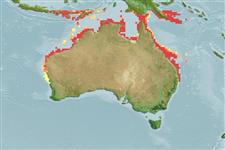Environment: milieu / climate zone / depth range / distribution range
Ecologie
marien; brak water demersaal; standvastig; diepte 0 - 10 m (Ref. 6205). Tropical; 8°S - 30°S, 110°E - 157°E (Ref. 6205)
Western Central Pacific: northern Australia, from Shark Bay, Western Australia to Moreton Bay, Queensland. Also known from the southern coast of New Guinea. Sillago nierstraszi is almost certainly a synonym of this species.
Grootte / Gewicht / Leeftijd
Maturity: Lm ? range ? - ? cm
Max length : 45.0 cm SL mannelijk / geslacht onbekend; (Ref. 6205); common length : 35.0 cm SL mannelijk / geslacht onbekend; (Ref. 9679)
Dorsale stekels (totaal): 12; Dorsale zachte stralen (totaal): 16-18; Anale stekels 2; Anale zachte stralen: 14 - 17; Wervels: 33 - 34. The shape of the swim bladder is not distinguishable from that of S. ciliata. The anterior part of the swim bladder has rudimentary tubules projecting anteriorly and a lateral series, that diminishes in size and becoming sawtooth-like, projecting posteriorly. Body is light silvery, slightly darker to dusky dorsally. A dull golden silver to golden yellow stripe is below the lateral line. The pelvic and anal fins are pale yellow to bright yellow; the pectoral fin has a darker dusting of fine black-brown spots.
Juveniles of this species, together with those of S. schomburgkii remain in warm waters of the shallow mangrove creek shorelines and protected inlets. Mature S. analis prefer the muddy, tidal streams. The preferred prey are crustaceans. They also rummage in the silty-sand substrates for worms and have been observed to 'plough' up the bottom with the snout (Ref. 6205). Oviparous (Ref. 205).
Levenscyclus en paargedrag
Maturiteit | Voortplanting | Paaien | Eieren | Fecunditeit | Larven
McKay, R.J., 1992. FAO Species Catalogue. Vol. 14. Sillaginid fishes of the world (family Sillaginidae). An annotated and illustrated catalogue of the sillago, smelt or Indo-Pacific whiting species known to date. Rome: FAO. FAO Fish. Synop. 125(14):87p. (Ref. 6205)
Status op de Rode Lijst van het IUCN (Ref. 130435)
Gevaar voor de mens
Harmless
Gebruik door de mens
Visserij: commercieel; Aquacultuur: mogelijk toekomstig gebruik
Meer informatie
Lokale namenSynoniemenMetabolismePredatorenEcotoxicologieVoortplantingMaturiteitPaaienPaaiaggregatiesFecunditeitEierenOntwikkeling van de eieren
ReferentiesAquacultuurAquacultuurprofielKweeklijnenGeneticaElectrophoresesErfelijkheidZiektesVerwerkingNutrientsMassaconversie
Tools
Speciale rapporten
Download XML
Internetbronnen
Estimates based on models
Preferred temperature (Ref.
123201): 24.6 - 28.7, mean 27.8 °C (based on 560 cells).
Fylogenetische diversiteitsindex (Ref.
82804): PD
50 = 0.5000 [Uniqueness, from 0.5 = low to 2.0 = high].
Bayesian length-weight: a=0.00851 (0.00366 - 0.01979), b=3.07 (2.86 - 3.28), in cm total length, based on LWR estimates for this (Sub)family-body shape (Ref.
93245).
Trofisch niveau (Ref.
69278): 3.3 ±0.1 se; based on diet studies.
Generation time: 2.2 ( na - na) years. Estimated as median ln(3)/K based on 1
growth studies.
Weerstandsvermogen (Ref.
120179): Hoog, minimale populatieverdubbelingstijd minder dan 15 maanden (Preliminary K or Fecundity.).
Fishing Vulnerability (Ref.
59153): Low to moderate vulnerability (28 of 100).
